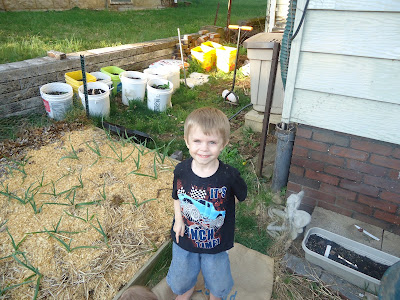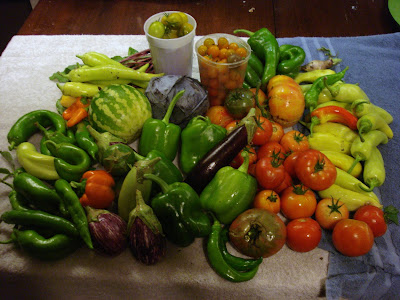It might not be obvious, but this is actually only the third year we have had any type of garden. In 2009 we had a single 4 x 4 bed that we filled with way too many plants from a big box store, almost all of which died from the blight that swept through that year. In 2010 we dug up the first few areas in the front yard and had a decent harvest, but we were able to nearly quadruple our output for 2011 by learning from the previous year's mistakes.
Here are the hits, misses, and things I've learned that will hopefully make 2012's garden even better:
1) Screw indoor seed starting. Eggplant, tomatoes, peppers and tomatillos will all be bought as seedlings from the fantastic organic city farm
Garden Dreams. There are just
too many factors working against having tiny little plants inside my house that waste my money. On top of that, I was able to get the kids interested in veggies that they would NEVER eat from the store by choosing all sorts of weird varieties. When I have room for 6 eggplants, buying 6 different seed packets and the dirt and supplies to grow them indoors is more costly than just buying the plants from people who know what they're doing.
2) Rabbits are no longer welcome. In 2010 we had barely any rabbit damage, but now they seem to know where the garden is and
visit it daily. Hopefully some short fencing will suffice since my options are limited.
3) Fruit! We have a fenced off sunny area in the back yard that will now be completely dedicated to fruit! I'm hoping to have ground cherries, strawberries, grapes, raspberries, blackberries and possibly melons growing there. In the fall we cluster-planted 3 dwarf pear, 2 dwarf plum, and 3 dwarf peach trees after taking down the old half-dead apple trees and may even plant some blueberry bushes along the side of the house in an area that otherwise fills up with weeds.
4) Moar carrots! Carrots in buckets were a
HUGE success! Radishes, by contrast, were a total failure AGAIN. I hope to add a few more buckets of carrots (right now I have 4) to the front yard and will only grow short-season carrots to allow for multiple harvests. We'll try radishes again in the ground but only because they won't waste much time if they fail.
5) Cull the herd. There are some vegetables that are just not worth the space to grow. We go through 10 to 20 pounds of onions a month, for example, and there is just no where to grow that many. By contrast, we could easily stock the freezer if we took the 5 x 5 bed that was used for onions and grew multiple crops of bush beans and trellised peas. Onions (even organic) are so inexpensive compared to peas and beans that eliminating onions from the garden just seems like a no brainer.
6) Better short season brassicas. Many of
our brassicas did pretty well this year, and we will buy the same variety of broccoli and red cabbage that we did last year. I will be trying new varieties of green cabbage and kohlrabi while adding some cauliflower. We do much better with short season veggies because there is less time for bad things to happen.
7) Disease resistant squash. Our summer squash and zucchini was attacked by
every single thing that can possibly harm it. Since I do not have the luxury of planting too far from the diseased ground of last season, I will be looking for varieties that are specifically resistant to as many mildews and pests as possible. This will come at the expense of being able to plant compact varieties, but since they will now have the larger hillside that was previously occupied by melons, it shouldn't be a problem.
8) Screw straw mulch. My garden was a weedy lawn not 2 years ago and the weed varieties tend to be the type that send out horrible strong vines that are impossible to follow through straw. I'll probably just rent a chipper and make mulch out of the giant pile of sticks we have in the fruit garden area.
9) No peppers in containers. They are just too finicky when it comes to wet weather, and things are so screwy that we can't bank on the sky cooperating. Peppers produced so fantastically in the ground this year that it just made the ones in containers look that much more
pathetic.
10) No volunteers. I let about 10 tomato volunteers grow this year, and had an amazing harvest of red grape tomatoes and some big meaty types from them. Unfortunately, several plants produced complete duds due to uncontrolled cross-breeding. I had three plants that never produced a single fruit without blossom end rot (even when growing right next to a plant producing healthy fruit) and another few that produced bland, boring tomatoes that were probably descendants of something store-bought. I'd much rather pick up some yummy clearance heirloom varieties late in the season and plant them in any spot large enough for volunteers.
There is also the issue of being better at using and preserving the harvest, and timing my plantings, but those are issues that will probably just get better each year. I planted some hard neck garlic this past fall and will be starting some early veggies this year, so hopefully it won't be too hard to watch everyone else start seeds indoors.
































































